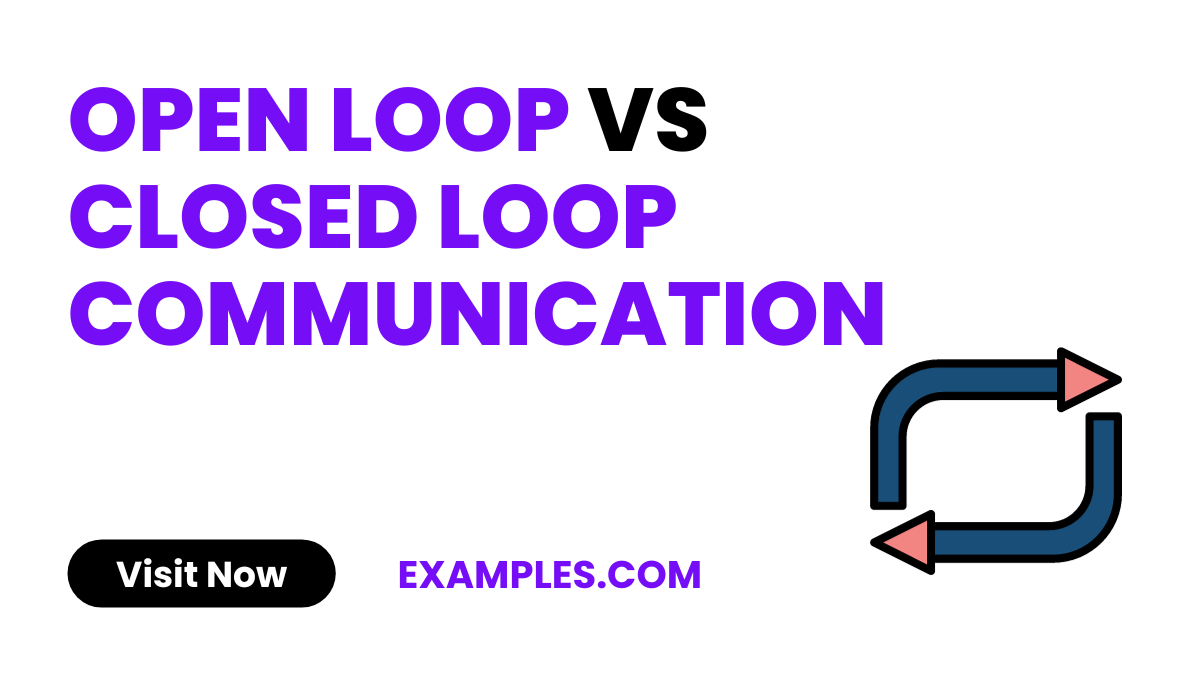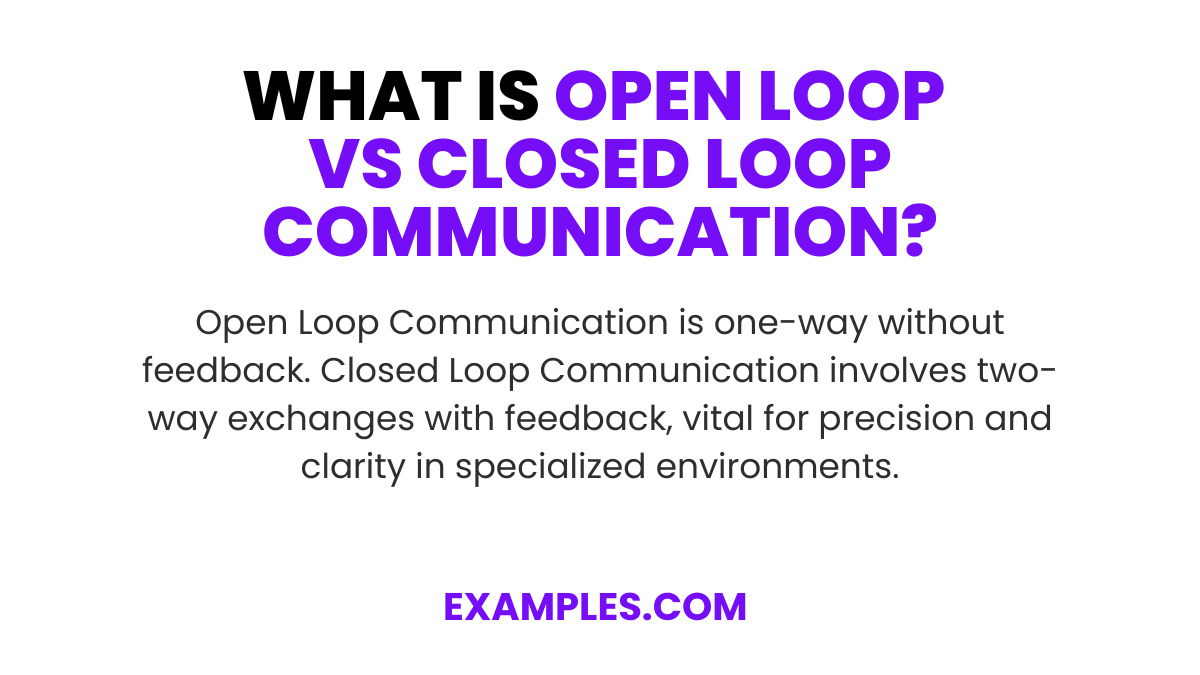Open Loop vs Closed Loop Communication: Examples, PDF
Embark on a comprehensive journey through Open Loop vs Closed Loop Communication. This guide illuminates the distinction with practical communication examples, demonstrating how each form operates within various contexts. Understand the mechanics behind the information flow and feedback mechanisms that define these communication models. Enhance your understanding and application of these concepts, crucial for effective personal and professional interactions.
Download Open Loop vs Closed Loop Communication Advantages and Disadvantages
What is Open Loop vs Closed Loop Communication? – Meaning
Open Loop Communication refers to a one-way information flow without feedback or input from the receiver, typical in broad broadcasts or announcements. In contrast, Closed Loop Communication involves a two-way exchange where the receiver provides feedback or confirmation, ensuring the message is understood correctly. This method is prevalent in environments requiring precision and clarity, such as healthcare or aviation. Understanding the distinction between these communication styles is vital for choosing the right approach in different scenarios, impacting effectiveness and outcome.
What is the Difference Between Open Loop vs Closed Loop Communication?
Open Loop Communication involves a one-way flow of information without expecting or requiring a response or feedback from the receiver. It’s typically used in settings like announcements where interaction isn’t necessary. On the other hand, Closed Loop Communication is a two-way process. It not only involves sending a message but also receiving a confirmation or feedback, ensuring the message was understood correctly. This method, integral to What is Closed Loop Communication? – Definition, Types, Examples, is essential in high-stakes environments where clarity is paramount, embodying Essential Actions for Closed Loop Communication.
Here’s a table outlining the differences between Open Loop and Closed Loop Communication:
| Aspect | Open Loop Communication | Closed Loop Communication |
|---|---|---|
| Definition | A one-way flow of information without requiring feedback from the receiver. | A two-way communication process that involves sending a message and receiving a confirmation or feedback. |
| Feedback | No feedback is expected or required from the receiver. | Feedback is essential and actively sought to ensure understanding. |
| Purpose | Typically used for broad announcements or information dissemination where interaction isn’t necessary. | Used in situations where clarity and understanding are crucial, such as in healthcare, aviation, or any team-based environment. |
| Interactivity | Non-interactive. The sender doesn’t expect any interaction from the receiver. | Highly interactive. It involves and engages both the sender and the receiver in the communication process. |
| Examples | Public announcements, general broadcasts, or informational emails. | Surgical procedures in healthcare, aviation commands, or any critical team-based operations. |
10 Open Loop Communication Examples
Explore ten distinctive examples of Open Loop Communication, a one-way information flow often used in broad, non-interactive contexts. This guide will walk you through various scenarios where Open Loop Communication is prevalent, from public broadcasts to automated messages. Each example will elucidate the typical causes of this communication style and provide insights into how and when it’s effectively utilized, despite its lack of feedback mechanism.
- Public Announcements: Airports use public address systems to inform passengers of boarding times and gate changes without expecting responses.
- Warning Signs: Signs that warn of dangers, like “High Voltage,” communicate critical information without any feedback required.
- Automated Emails: Companies send out mass marketing emails to clients, providing information without a direct pathway for response.
- News Broadcasts: Television or radio news broadcasts deliver information to a wide audience who are receivers of information only.
- Social Media Posts: Brands post updates or advertisements on social media, reaching a broad audience without direct engagement.
- Instruction Manuals: Manuals provide step-by-step instructions for product assembly or use, typically without expecting feedback.
- Billboards: Large outdoor billboards display advertisements or information to passersby, without any interaction.
- Emergency Alerts: Systems send out emergency alerts like weather warnings to mass populations as a one-way notification.
- Lecture Sessions: In some educational settings, lecturers deliver information without pausing for student feedback or interaction.
- Informational Brochures: Brochures and flyers provide detailed information about services, events, or products, generally without immediate feedback.
10 Closed Loop Communication Examples
Delve into ten unique examples of Closed Loop Communication, characterized by its two-way interactive nature that ensures clarity and mutual understanding. This guide presents various instances across different sectors where Closed Loop Communication is vital, emphasizing its role in reducing misunderstandings and enhancing effectiveness. Each scenario illustrates how this communicative approach is implemented, the typical challenges it addresses, and the ways it fosters accurate and reliable exchanges.
- Medical Orders in Healthcare: A nurse repeats back a doctor’s prescription to confirm the correct medication and dosage is administered.
- Aviation Cockpit Commands: Co-pilots confirm back the received instructions from the captain to ensure accuracy in flight operations.
- Military Operations: Soldiers confirm received orders back to the commanding officer to ensure clear and accurate execution.
- Customer Service Interactions: Service representatives repeat customer issues and solutions to confirm understanding and resolution.
- Restaurant Order Taking: Waitstaff repeat customer orders to avoid mistakes and ensure customer satisfaction.
- Project Team Updates: Team members summarize and confirm next steps in a project meeting to align on tasks and responsibilities.
- Safety Drill Coordination: During drills, participants confirm each completed safety step to ensure no critical procedure is missed.
- Manufacturing Instructions: Operators repeat back machine setup instructions to confirm they are correct before proceeding.
- Software Development Testing: Testers provide detailed feedback to developers, who then confirm understanding of the issues and required fixes.
- Educational Classroom Responses: Teachers ask students to summarize the lesson or instructions to ensure content comprehension.
Comparison between Open Loop vs Closed Loop Communication
Open Loop Communication involves a one-way transfer of information, often used in broadcasting messages where no response is required. In contrast, Closed Loop Communication is an interactive exchange where feedback or acknowledgment is integral. It includes specific Closed Loop Communication Steps like the sender delivering the message, the receiver acknowledging, and then confirming the message’s content. Particularly in healthcare, Closed Loop Communication in Healthcare and Closed Loop Communication in Nursing are crucial for patient safety and care coordination, reflecting the Importance of Closed Loop Communication in reducing errors and ensuring precise understanding in critical settings. The comparison between Open Loop and Closed Loop Communication highlights their distinct approaches to the exchange of information:
Open Loop Communication:
- Direction: It’s a one-way flow of information from the sender to the receiver without any expected feedback or acknowledgment.
- Feedback: There is no mechanism for the receiver to confirm understanding or to provide feedback to the sender.
- Contexts: It’s often used in mass communication like announcements, advertisements, or public broadcasts where individual feedback isn’t feasible or necessary.
- Advantages: Efficient for quickly disseminating information to a large audience; requires less time and resources than interactive communication.
- Disadvantages: Risk of misunderstanding as there is no confirmation the message has been understood correctly; not suitable for complex or critical information that requires confirmation.
Closed Loop Communication:
- Direction: It involves a two-way exchange where the receiver provides feedback or confirmation back to the sender.
- Feedback: Essential and actively sought to ensure the message was received and understood correctly; involves repeating or paraphrasing the received information.
- Contexts: Critical in high-stakes environments like healthcare, aviation, or any setting where precision and understanding are crucial.
- Advantages: Reduces misunderstandings and errors by ensuring the message is clearly understood; fosters a collaborative environment by involving all parties in the communication process.
- Disadvantages: More time-consuming and resource-intensive due to the need for back-and-forth interaction; may not be practical for communicating with large groups.
Relationship between Open Loop vs Closed Loop Communication
The relationship between Open Loop and Closed Loop Communication is defined by their context and application in ensuring effective information exchange. Open Loop Communication, often used in broad, non-interactive settings, doesn’t involve feedback, making it quick and widespread. In contrast, Closed Loop Communication, essential in high-stakes or personal settings, involves a feedback mechanism, ensuring the message is understood and acted upon correctly. This is particularly evident in Closed Feedback Loop Communication, vital for precise interactions. Closed Loop Communication for Patients and Nurses and Closed Loop Communication in Medical settings are quintessential examples where the accuracy and confirmation of information can significantly impact outcomes, emphasizing the need for clear, two-way communication in healthcare. The relationship between Open Loop and Closed Loop Communication is characterized by their distinct approaches to information exchange, each serving different purposes in communication dynamics.
- Complementarity: While Open Loop Communication is effective for broad, non-interactive messaging like announcements or general information dissemination, Closed Loop Communication is essential in situations requiring confirmation and clarity, such as in healthcare or team-based projects.
- Contextual Application: The choice between Open Loop and Closed Loop Communication often depends on the context and the need for feedback. Open Loop is suitable for straightforward, informative messages, whereas Closed Loop is crucial for complex instructions or discussions where misunderstandings could have serious consequences.
- Feedback Mechanism: The key differentiator is the feedback mechanism. Open Loop lacks this, making it quick and efficient for wide-reaching communication. In contrast, Closed Loop involves an interactive exchange, ensuring the message is correctly received and understood.
- Efficiency vs. Accuracy: Open Loop Communication is more efficient for reaching a larger audience quickly, but it risks misunderstandings due to the lack of feedback. Closed Loop Communication, while more time-consuming, enhances accuracy and understanding.
- Situational Adaptation: Effective communicators often adapt between these two styles depending on the situation’s requirements. For example, a manager might use Open Loop Communication to disseminate general company updates but switch to Closed Loop for team-specific tasks to ensure clarity and comprehension.
In conclusion, understanding Open Loop vs Closed Loop Communication is crucial, with each having specific Communication Benefits in different contexts. Open Loop offers broad, efficient information dissemination, while Closed Loop ensures accuracy and understanding, underlining Communication Importance in various sectors. Balancing these methods according to situational needs can enhance clarity, reduce errors, and improve overall communication effectiveness in personal and professional settings.





